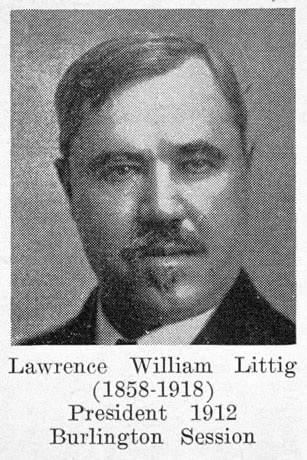Main navigation
Researched and Written by
Dr. Fred Stamler
The University Catalogue of 1892-93 announced the addition of a Department of Pathology and Bacteriology to the Medical Department. The Chair was to be filled before the next term, and assurance was given that instruction would be "thorough and practical". Dr. J.M. Parker of Davenport was listed as Professor of Pathology and Bacteriology and curator of the medical museum with Water L. Bierring, a senior student, as Demonstrator of Pathology. Dr. Parker was to play a temporary role, as Walter Bierring had already been approached with the offer of Headship of the Department, conditional upon his obtaining the MD degree and completing appropriate post-graduate studies in leading European medical centers. He received his MD degree in the spring of 1892, and within a few days had embarked on his European odyssey to prepare himself for the position of Professor of Pathology and Bacteriology at the beginning of the 1893-94 session.

Dr. Bierring, in later years, gave much of the credit for the origin of the Department to Dr. Lawrence Littig, an Iowa graduate who returned to Iowa City in 1888 to become Professor of Anatomy. Dr. Littig held a second degree from the University of Pennsylvania and membership in the Royal College of Surgeons of London, and had spent four years studying in medical centers of London, Berlin, Vienna, and Paris. He brought the first oil immersion microscope to Iowa City, and used it to demonstrate to students the tubercle bacillus in sputum, and other microorganisms identified as causes of infectious diseases prevalent at the time. Prior to this, bacteriology had been taught by Professor Thomas H. McBride, Professor of Botany in the "Collegiate Department". McBride was expert in many botanical subjects, including mycology and bacteriology, but avoided use of organisms pathogenic to man in his laboratory courses. In 1892, Dr. Littig transferred to become Head of the Department of Theory and Practice of Medicine, and this apparently ended his direct involvement with the teaching of laboratory medicine.
Important impetus to the growth of laboratory medicine at Iowa City was also given by Elbert W. Rockwood. He became Demonstrator of Chemistry in 1888, having first attained the title of Professor of Chemistry and Toxicology in 1882. After several title changes through the years, he again held that title at his death in 1935. He came to Iowa City from the Strassburg laboratory of Hoppe-Seyler a leading physiological chemist of the time, Rockwood organized and taught one of the first courses of physiologic chemistry in this part of the country, and it soon became an important part of the medical school curriculum.
Dr. Parker gave a series of lectures on Pathology during the 1891-92 year, but did not include laboratory work. Illness prevented his finishing the course or conducting it the following year. Laboratory work in Pathology and Histology during this time was directed by Professor Samuel Calvin of the Geology Department, assisted by Drs. E.H. Williams and Frank S. Aby. The qualifications of Professor Calvin in this capacity are not recorded, and Dr. Williams had no further recorded involvement in the Department. Dr. Aby remained on the faculty for several years as Professor of Normal Histology.